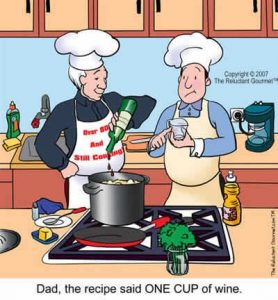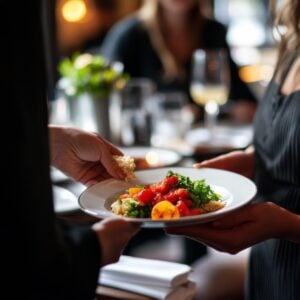How to Teach Your Kids Proper Table Manners
My mother hosted elegant cocktail parties in the 1960s, punctuated by martinis, deviled quail eggs, and all the latest orange-on-pink raw silk fashions. Her attention to elegance extended to the family dinner table, where we were expected to display impeccable table manners and were briskly taken to task in the event of a momentary lapse.
My mother would pepper our father-led conversations of current events with jabs like “Get your elbows off the table,” “sit up,” “Put your napkin on your lap” or (my personal favorite) “Don’t use your fingers to push peas onto your fork!” (She bought me a “pusher” out of frustration. If you’ve never seen one of these, why would you have? — Google “antique silver food pusher,” and you’ll get the idea. That mortified me into toeing the line.)
To further her efforts to raise children who wouldn’t embarrass her at a dinner party, she circulated among the five of us her 1961 copy of Tiffany’s Table Manners for Teenagers, by Walter Hoving. By the time it got handed down to me, the baby of the family, I had already learned all the humorous quips from my siblings as they poked fun at its contents, but frankly, I read it over and over with great fascination.
That my mother’s incessant needling was backed by a body of work, authored by the CEO of Tiffany’s no less, captivated me. I don’t know what I thought I was preparing for, but all those do’s and don’ts struck a chord. Imagine how happy my two daughters are about that!
With the 2011 release of the 50th Anniversary Edition, my kids each have Tiffany’s Table Manners for Teenagers, updated by the author’s son. I was delighted to see some of my pet peeves as a mother included.
Here’s the thing about table manners – unless you’re a very young child, nobody notices you have them unless you fail to display them. So, I thought I’d share a few of my favorites that may be less mainstream but nonetheless worth knowing, at least in my view:
Salt & Pepper Shaker
The salt and pepper are meant to be passed together, even if only one is requested. They’re a pair, and they don’t like to be separated. Don’t assume that everyone knows this rule, so when you want just one or the other, ask for them both and spare your less-informed dining companions from committing a faux pas.
Silverware
When you’re at a dinner party, and there is more than one piece of silverware (three forks, two spoons), the first thing you can conclude is that there will be more than one course! But more to the point, the silverware is most likely arranged from the outside; that is, you start with the fork furthest away from the plate and work your way in with each successive course.
Sometimes, silverware is ordered by size, so if in doubt, watch what your hostess or host picks up and follow suit. Usually, this isn’t an issue at restaurants, as the waiter will typically bring whatever fork, knife, or spoon you need for whatever you’re eating next. Finally, if you mess up, just keep eating—if you don’t make an issue of it, no one else will either.
(Side story: when my kids were little, I was happy if they ate with anything other than their hands. It became such a dinnertime battle that we finally took them to an Ethiopian restaurant that didn’t use utensils, thinking they’d relish the opportunity to eat with their grubby little paws. Wouldn’t you know, my then 6-year-old freaked out when I informed her there was no fork? Nor spoon. Nor spork. Luckily, a plastic utensil was in the back room, and she could get enough in her mouth to keep her body and soul together for another day. Go figure.)
Table Glasses
Back to the dinner party: your water is to your right, and your bread is to your left. Here’s how you remember, so you don’t garishly sully your dining companion’s water glass with your lipstick or chapstick or cooties or whatever: as you contemplate which way to reach for what, make an “OK” sign with each of your hands.
You’ll note that your left hand looks like a small “b,” and your right hand looks like a small “d.” The B (on your left hand, hence left) stands for bread and D (on your right hand, etc.) stands for drink. Got it?
Talking & Chewing
Here’s a big one at our house: “Don’t talk with food in your mouth.” It seems obvious, but it’s easier said than done (no pun intended).
Early on, we established the routine of having dinner as a family so that we could catch up on each other’s day and just spend time together. So the two activities are talking and eating. But you can’t do them at the same time?
Try explaining that to a 5-year-old who’s itching to be excused from the table anyway. Whether or not it makes sense is beside the point; it’s just gross. So adults, think before you speak, then swallow and proceed.
One hint from Tiffany: Take small bites. Then, your companions won’t have to wait long for you to finish chewing before sharing your next witty insight.
Elbows
A final favorite (though I could go on and on) is to pay attention to your elbows. They should not rest on the table while eating, although it’s okay to rest them there while talking.
And keep them by your sides, don’t have them sticking out as you cut your meat as you are likely to clock your dining companion in the ear. Whatever you do, don’t sling them over the back of your chair—enough said.
Final Thought
One final thought – there are countless benefits to eating dinner as a family, and one of them is that it provides a forum to teach your children about any manner of things, including manners. It makes them and us a better company.
Here’s a great infographic describing some of these tips and a few more important to learn and teach your kids.
From Visually.














One Response
Wonderful!! Al bought a dozen copies of that book and handed them out to many glum teens.